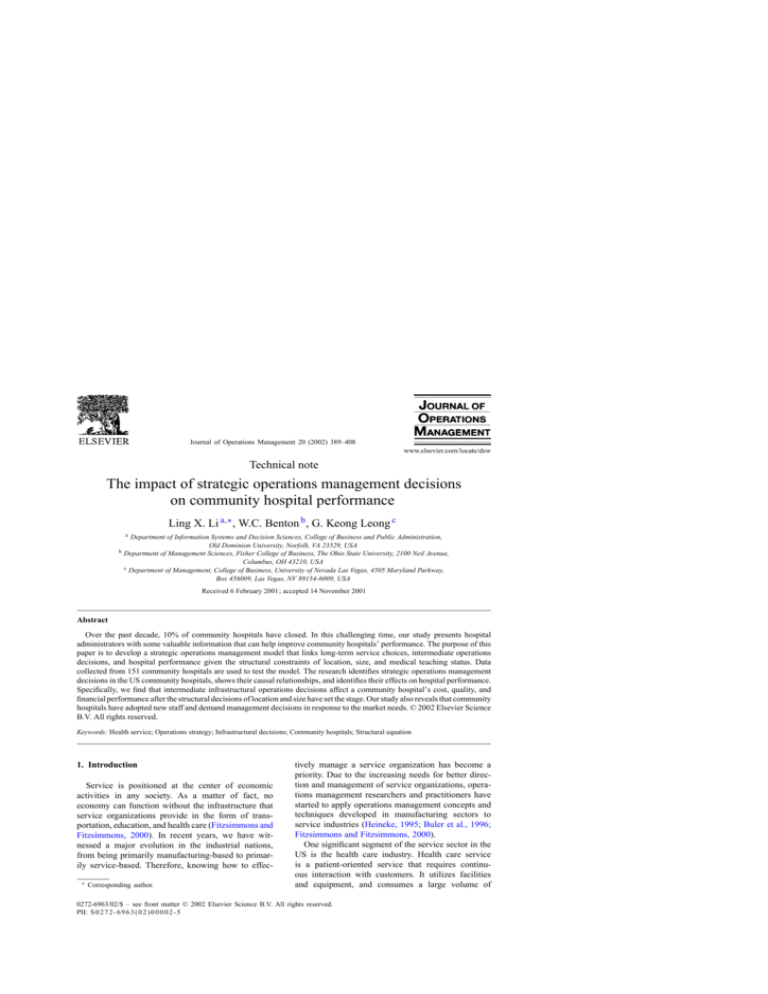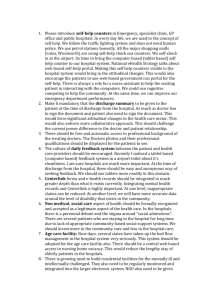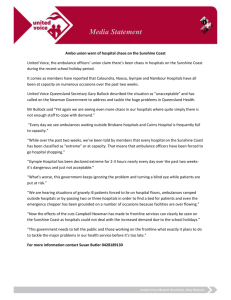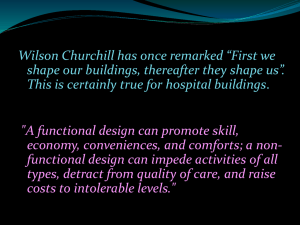
Journal of Operations Management 20 (2002) 389–408
Technical note
The impact of strategic operations management decisions
on community hospital performance
Ling X. Li a,∗ , W.C. Benton b , G. Keong Leong c
a
b
Department of Information Systems and Decision Sciences, College of Business and Public Administration,
Old Dominion University, Norfolk, VA 23529, USA
Department of Management Sciences, Fisher College of Business, The Ohio State University, 2100 Neil Avenue,
Columbus, OH 43210, USA
c Department of Management, College of Business, University of Nevada Las Vegas, 4505 Maryland Parkway,
Box 456009, Las Vegas, NV 89154-6009, USA
Received 6 February 2001; accepted 14 November 2001
Abstract
Over the past decade, 10% of community hospitals have closed. In this challenging time, our study presents hospital
administrators with some valuable information that can help improve community hospitals’ performance. The purpose of this
paper is to develop a strategic operations management model that links long-term service choices, intermediate operations
decisions, and hospital performance given the structural constraints of location, size, and medical teaching status. Data
collected from 151 community hospitals are used to test the model. The research identifies strategic operations management
decisions in the US community hospitals, shows their causal relationships, and identifies their effects on hospital performance.
Specifically, we find that intermediate infrastructural operations decisions affect a community hospital’s cost, quality, and
financial performance after the structural decisions of location and size have set the stage. Our study also reveals that community
hospitals have adopted new staff and demand management decisions in response to the market needs. © 2002 Elsevier Science
B.V. All rights reserved.
Keywords: Health service; Operations strategy; Infrastructural decisions; Community hospitals; Structural equation
1. Introduction
Service is positioned at the center of economic
activities in any society. As a matter of fact, no
economy can function without the infrastructure that
service organizations provide in the form of transportation, education, and health care (Fitzsimmons and
Fitzsimmons, 2000). In recent years, we have witnessed a major evolution in the industrial nations,
from being primarily manufacturing-based to primarily service-based. Therefore, knowing how to effec∗
Corresponding author.
tively manage a service organization has become a
priority. Due to the increasing needs for better direction and management of service organizations, operations management researchers and practitioners have
started to apply operations management concepts and
techniques developed in manufacturing sectors to
service industries (Heineke, 1995; Buler et al., 1996;
Fitzsimmons and Fitzsimmons, 2000).
One significant segment of the service sector in the
US is the health care industry. Health care service
is a patient-oriented service that requires continuous interaction with customers. It utilizes facilities
and equipment, and consumes a large volume of
0272-6963/02/$ – see front matter © 2002 Elsevier Science B.V. All rights reserved.
PII: S 0 2 7 2 - 6 9 6 3 ( 0 2 ) 0 0 0 0 2 - 5
390
L.X. Li et al. / Journal of Operations Management 20 (2002) 389–408
nursing care. Therefore, it becomes increasingly important to health care executives to understand what
kind of facility, equipment, and workforce decisions
are critical to achieve the commonly acknowledged
goal of providing quality health service at a reasonable
cost.
The health care industry uses management models
that were developed in manufacturing to improve its
performance. In the late 1980s and early 1990s, health
care professionals adapted quality control methods
such as the Fishbone Diagram and quality control
charts used by US manufacturers (Berwick et al.,
1991). Recent health care research suggests that the
health care industry can apply strategic operations
management models developed in manufacturing to
achieve better performance in the changing health care
environment (Heineke, 1995; Roth and Van
Dierdonck, 1995; Buler et al., 1996).
Community hospitals account for 80% of US hospitals (AHA Survey of Hospital Data Base, 1995).
A community hospital is a non-federal short-term
general or other special hospital that is not a hospital unit of an institution (AHA Survey of Hospital
Data Base, 1995). Until now research on operations
strategy in community hospitals has not been well developed, especially when it relates operations strategy
to the current health service condition. Most of the
operations-oriented studies focus narrowly on issues
of hospital cost containment, capacity planning, or
personnel scheduling (Buler et al., 1996). For example,
Roth discusses a strategic model that focuses on hospital technology management (Roth and Johnson,
1996), and another model that studies hospital resource management using the Material Requirements
Planning concept (Roth and Van Dierdonck, 1995).
Heineke (1995) applies the Hayes and Wheelwright
strategic manufacturing model to health service,
specifically in the infrastructure management of obstetric departments. Through these innovative studies,
the conceptual background for integrating strategic operations management to hospital administration is established. However, few examples can be
cited where long-term structural decisions, intermediate operations decisions, and performance are included explicitly in the management of health service
operation.
Over the past decade, even as an aging population is consuming more health services, about
10% of US community hospitals have closed due
to low occupancy rates and poor financial performance (Anonymous, 2001). The existing community hospitals are trying to find ways to survive,
or even thrive, in the competitive health service
market. Many strategic decisions, such as adding
outpatient health service plans and partnering with
physicians, have been used to improve market presence, utilization, and care condition (Edlin, 2001).
At the same time, health care administrators have
begun to realize that focusing on one decision area,
such as structural decisions, is not enough. Instead,
developing a congruent operations strategy is the
key to improving a hospital’s utilization and financial performance (Buler et al., 1996). The purpose
of our study is to develop a strategic operations
management model that links long-term equipment
and service choices, intermediate operations decisions, and performance given structural constraints
for community hospitals. The expected contributions of this study include a better understanding
of strategic operations management decisions in
the US community hospitals, identifying the causal
relationships among operations decisions, and recognizing their effects on hospital performance. The
research is further expected to find out the key strategic decisions that can help improve a community
hospital’s performance in the changing health service
environment.
There are two issues discussed in this study.
First of all, given the structural constraints of location, size, and medical teaching status, what are
the long-term service choices and intermediate infrastructural operations decisions developed by US
community hospitals in response to the market needs
in the current health service environment? Secondly,
with various structural constraints, how do intermediate infrastructural operations decisions impact a
hospital’s cost and quality measures and financial
performance? The effects of intermediate decisions
on performance are emphasized in this study because a previous study has suggested that health
service, such as obstetric departments, relies upon a
well-managed intermediate infrastructure decisions
to deliver quality health service at a reasonable cost
(Heineke, 1995). Several hypotheses related to the
two research questions will be presented in the next
section.








